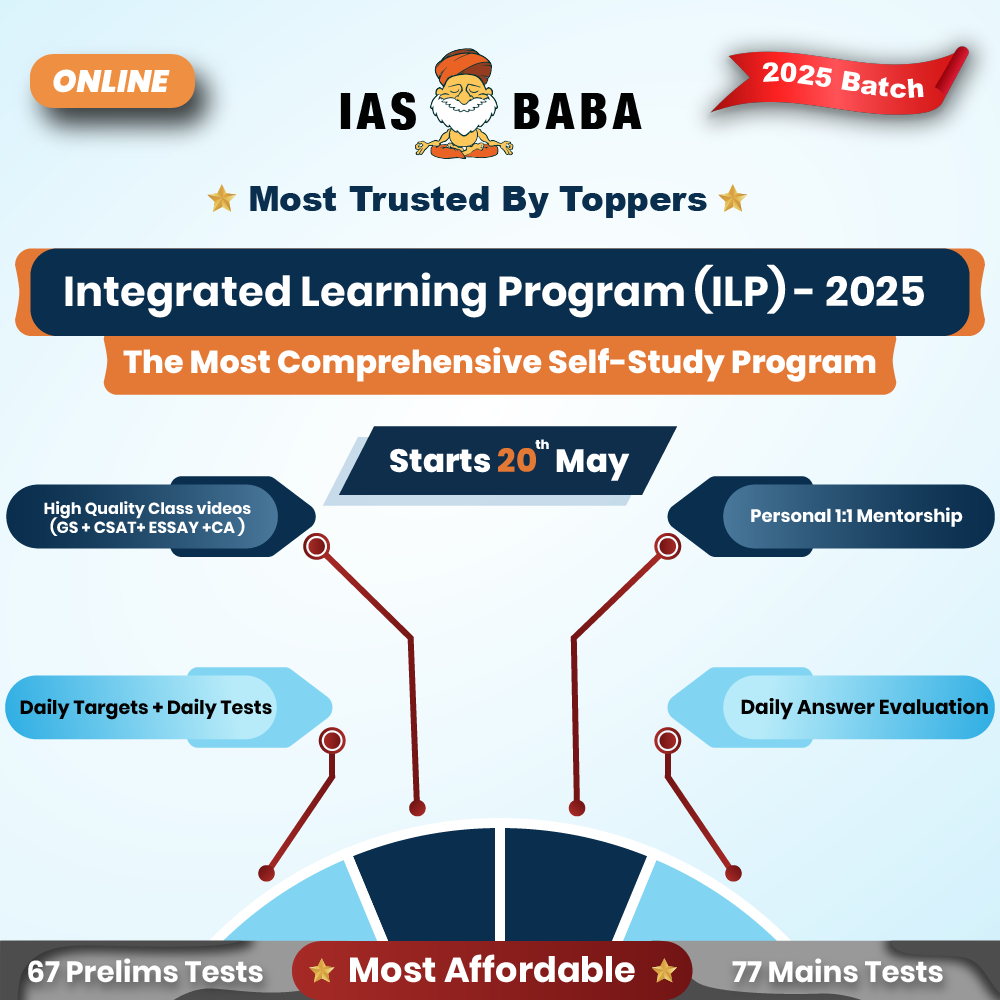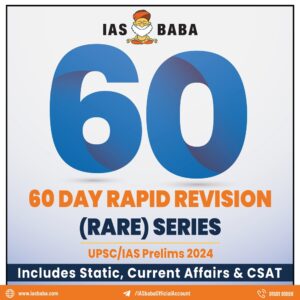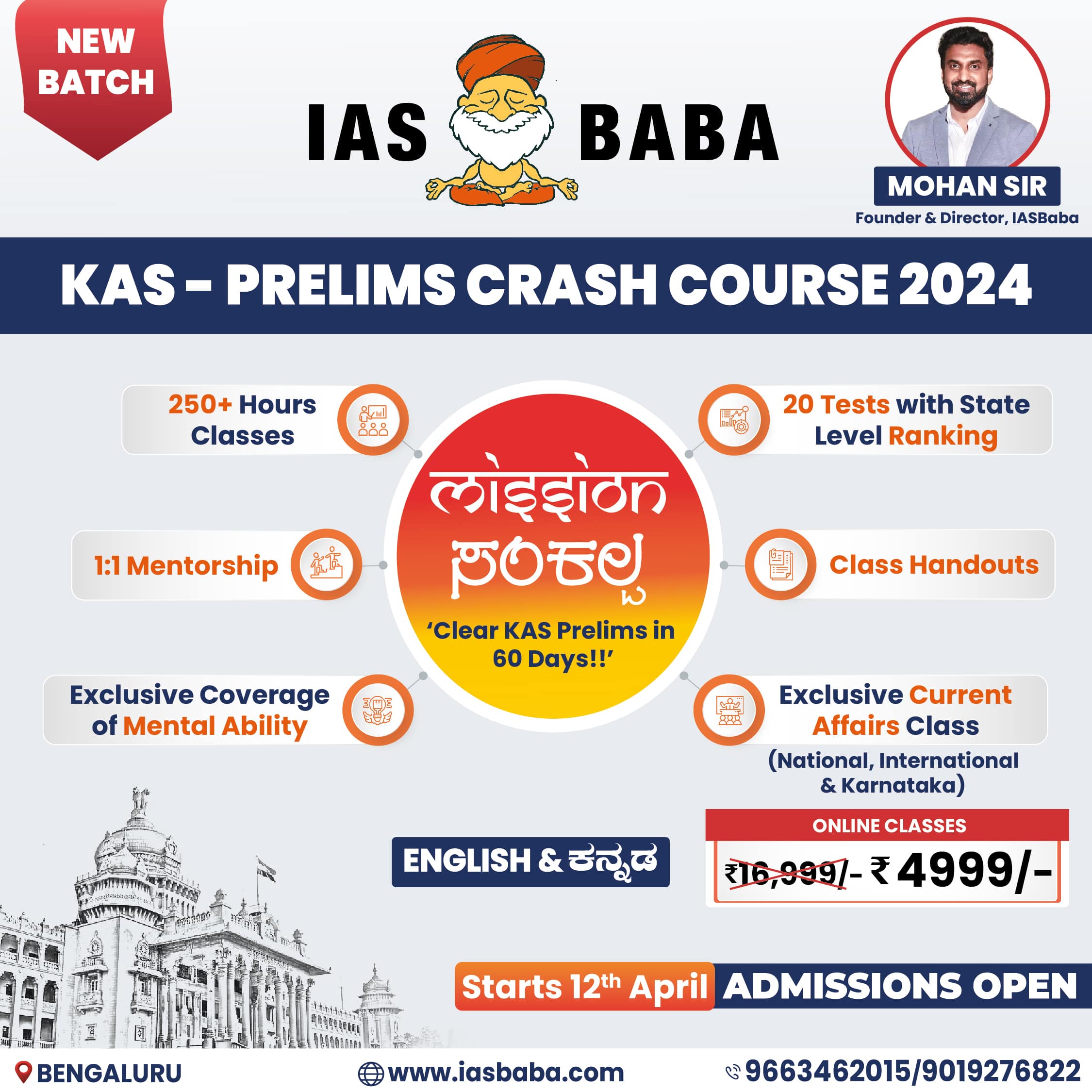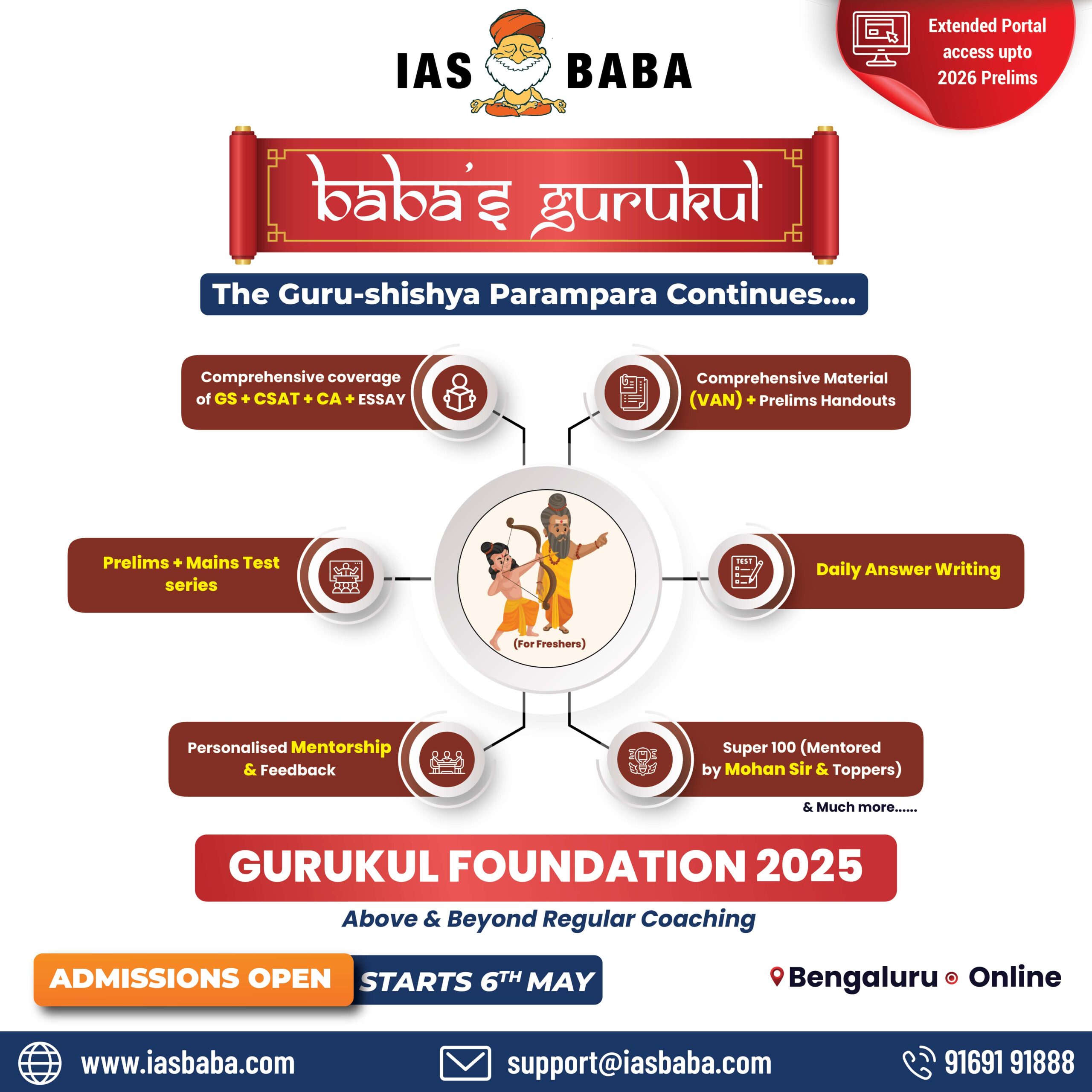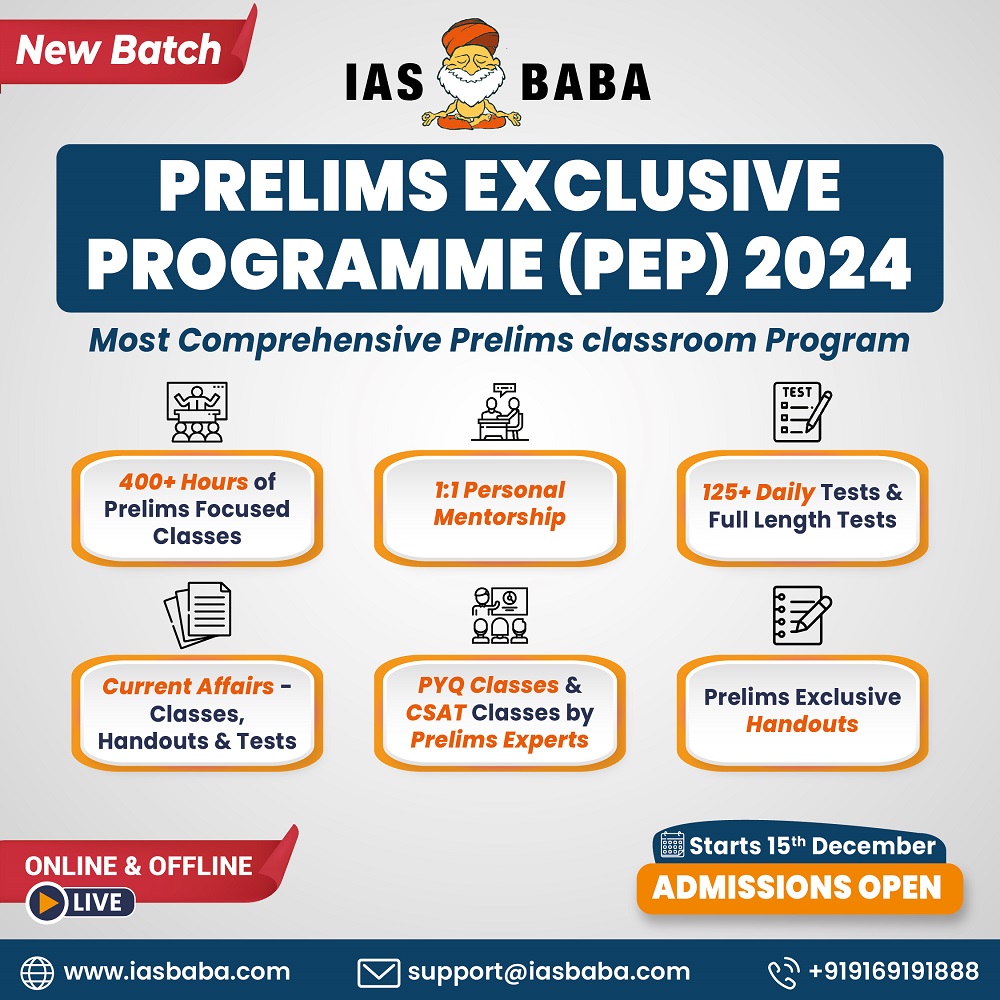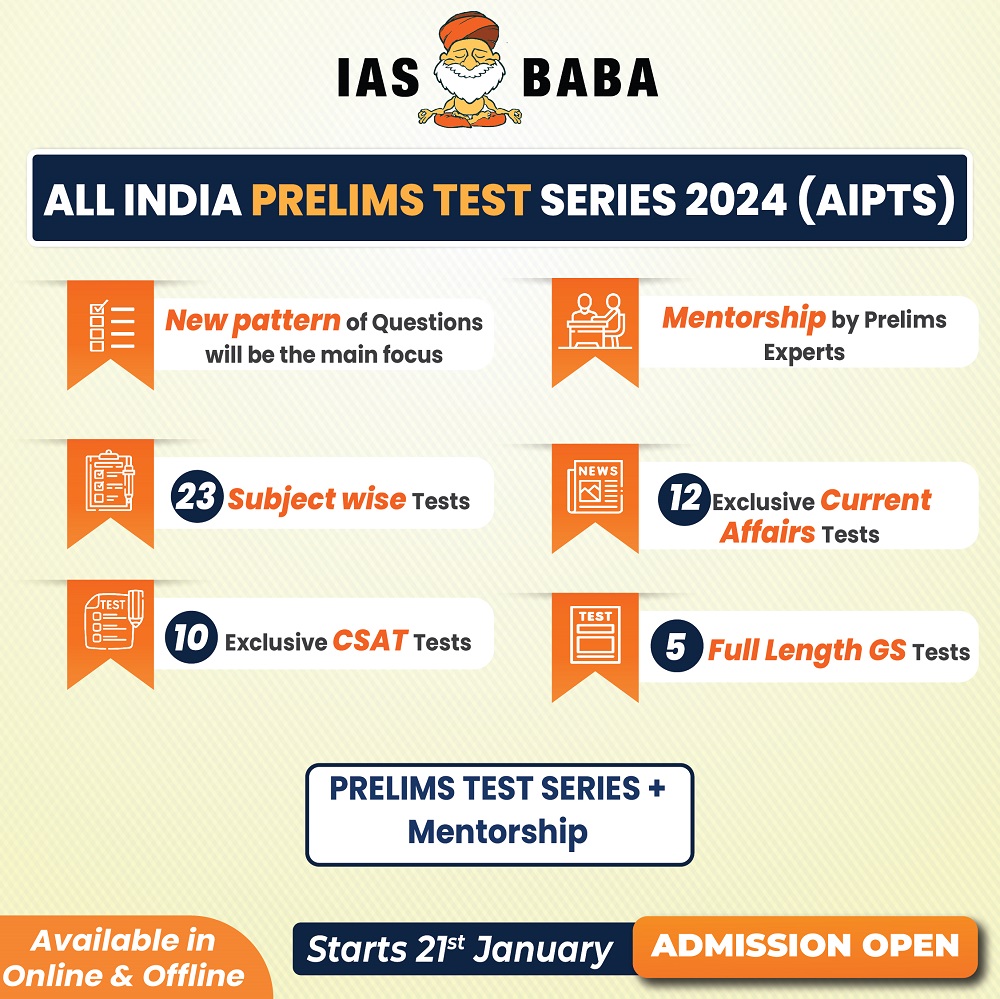IASbaba's Daily Current Affairs Analysis
Archives
(PRELIMS & MAINS Focus)
Syllabus
- Prelims –GOVERNMENT SCHEMES
Context: Recently, Odisha’s Debrigarh, Khinda was included in the Ministry of Tourism’s Swadesh Darshan 2.0 scheme.
Background:-
- Debrigarh Wildlife Sanctuary and Khinda Village will be developed under the scheme as sustainable and responsible destinations with a tourist and destination-centric approach.
About Swadesh Darshan 2.0 scheme:-
- Ministry: Ministry of Tourism.
- Objective: to realize India’s full potential as a tourist destination and promote “vocal for local” as its guiding principle.
Salient Features:-
- The redesigned program known as Swadesh Darshan 2.0 aims to develop sustainable and responsible destinations with a tourist and destination-centric approach and has shared the guidelines for the SD2.0 scheme.
- The Scheme is 100% centrally funded.
- The projects under this scheme are sanctioned subject to the availability of funds, submission of suitable Detailed Project Reports (DPR), adherence to scheme guidelines and utilisation of funds released earlier etc.
- Swadesh Darshan 2.0 is a generational shift to transform the Swadesh Darshan Scheme into a holistic mission to create sustainable and responsible tourism destinations. It is not an incremental change.
- With a focus on tourists and destinations, it will aid in the creation of sustainable and responsible destinations.
- It will encourage the creation of generic and theme-specific benchmarks and standards for the development of tourism destinations, and states will adhere to those benchmarks and standards when planning and developing projects.
- Some of the prominent places identified are Jhansi and Prayagraj in Uttar Pradesh, Gwalior, Chitrakoot and Khajuraho in Madhya Pradesh and Ajanta and Ellora in Maharashtra.
- The Scheme has identified the following significant tourism themes:
- Tourism of Culture and Heritage
- Adventure Tourism
- Eco-Tourism
- Wellness Tourism
- MICE Tourism
- Rural Tourism
- Beach Tourism
- Cruises – Inland and Ocean
Significance:-
- The revamped scheme seeks to enhance the contribution of tourism to local economies.
MUST READ: Promotion of Buddhist Sites under Swadesh Darshan & PRASHAD
SOURCE: THE NEW INDIAN EXPRESS
PREVIOUS YEAR QUESTIONS
Q.1) With reference to Pradhan Mantri Kaushal Vikas Yojana, consider the following statements : (2018)
- It is the flagship scheme of the Ministry of Labour and Employment.
- It, among other things, will also impart training in soft skills, entrepreneurship, financial and digital literacy.
- It aims to align the competencies of the unregulated workforce of the country to the National Skill Qualification Framework.
Which of the statements given above is/are correct?
- 1 and 3 only
- 2 only
- 2 and 3 only
- 1, 2 and 3
Q.2) What is the aim of the programme ‘Unnat Bharat Abhiyan’? (2017)
- Achieving 100% literacy by promoting collaboration between voluntary organizations and the government’s education system and local communities.
- Connecting institutions of higher education with local communities to address development challenges through appropriate technologies.
- Strengthening India’s scientific research institutions in order to make India a scientific and technological power.
- Developing human capital by allocating special funds for health care and education of rural and urban poor, and organizing skill development programmes and vocational training for them.
Syllabus
- Prelims –POLITY
Context: Recently, the Ministry of Panchayati Raj organized a “Two-Day Regional Conference on Strengthening of the Panchayats (Extension to Scheduled Areas) Act, 1996” (PESA Act, 1996).
Background:-
- The conference will commence with an ‘Inaugural Session’ in the presence of Shri Vivek Bharadwaj, Additional Secretary, Dr. Chandra Shekhar Kumar, Joint Secretary, Smt. Mamta Varma, Principal Secretary, Rural Development & Panchayati Raj Department, Government of Maharashtra Shri Eknath Dawale.
About Panchayats (Extension to Scheduled Areas) Act, 1996” (PESA Act, 1996):-
- Enacted: 1996.
- Objective: to provide for the extension of the provisions of Part IX of the Constitution relating to the Panchayats to the Scheduled Areas.
- It is an Act to provide for the extension of the provisions of Part IX of the Constitution relating to the Panchayats to the Scheduled Areas.
- The Part IX of the Constitution, which consists of Articles 243-243ZT, covers legislation related to municipalities and cooperative societies in addition to Panchayats.
- The Panchayat Extension to Scheduled Areas (PESA) Act 1996 came into existence after the Bhuria Committee’s recommendations in 1995.
- The PESA Act acknowledges the right of tribal communities, who live in Scheduled Areas, to rule themselves using their own systems of self-government.
- The Act gives Gram Sabhas the authority to play an important part in approving development plans and managing all social sectors.
- Under the PESA Act, Scheduled Areas are those referred to in Article 244(1), which says that the provisions of the Fifth Schedule shall apply to the Scheduled Areas and Scheduled Tribes in states other than Assam, Meghalaya, Tripura, and Mizoram.
Role of State Government:-
- PESA, was enacted by the Centre to ensure self-governance through gram sabhas (village assemblies) for people living in scheduled areas.
- State governments were required to amend their respective Panchayat Raj Acts without making any law that would be inconsistent with the mandate of PESA.
- To legally recognize the right of tribal communities, and residents of the scheduled areas, to govern themselves through their own systems of self-government.
- It acknowledges their traditional rights over natural resources.
Powers and functions provided to the Gram Sabhas:-
- Right to mandatory consultation in land acquisition, resettlement and rehabilitation of displaced persons.
- Protection of traditional beliefs, the culture of the tribal communities.
- Ownership of minor forest products.
- Resolution of the local disputes.
- Prevention of land alienation.
- Management of village markets.
- Right to control production, distillation, and prohibition of liquor.
- Exercise of control over money-lending.
- Any other rights involving the Scheduled Tribes.
MUST READ: E-PANCHAYAT FACILITY
SOURCE: PIB
PREVIOUS YEAR QUESTIONS
Q.1) With reference to the Ayushman Bharat Digital Mission, consider the following statements: (2022)
- Private and public hospitals must adopt it.
- As it aims to achieve universal health coverage, every citizen of India should be part of it ultimately.
- It has seamless portability across the country.
Which of the statements given above is/are correct?
- 1 and 2 only
- 3 only
- 1 and 3 only
- 1, 2 and 3
Q.2) The Government enacted the Panchayat Extension to Scheduled Areas (PESA) Act in 1996. Which one of the following is not identified as its objective? (2013)
- To provide self-governance
- To recognize traditional rights
- To create autonomous regions in tribal areas
- To free tribal people from exploitation
Syllabus
- Prelims –GOVERNANCE
Context: Recently, a Chinese student who was a victim of ‘cyber kidnapping’ has been found in rural Utah, unharmed.
Background:-
- The 17-year-old, Kai Zhuang, was reported missing on December 28. By the time the police traced him, his parents back in China had paid $80,000 in ransom.
About cyber kidnapping:-
- Cyber kidnapping refers to a crime where the ‘kidnappers’ convince their victim to hide, and then contact their loved ones for ransom.
- The victim is also made to send pictures that make it look like they are being held captive and showing them bound or gagged.
- These are then shared with the family.
- Both parties believe their loved ones will be harmed if they don’t do as the kidnappers ask.
- The ‘kidnappers’, though not physically present, monitor the victim online through video-call platforms.
- Unlike traditional kidnaps virtual kidnappers have not actually kidnapped the victim.(Cybercrime)
- Instead, through the deceptions and threats the kidnapers coerce victims to pay a quick ransom before the scheme falls apart.
- Perpetrators coerce victims into hiding or simulating situations of captivity.
- Scammers exploit psychological vulnerabilities, leveraging personal information gathered from social media or other sources to make their demands appear credible.
- Criminals may use video-call platforms to monitor victims online, creating a façade of constant surveillance.
Prevention:-
- Limit Online Sharing.
- Caller Vigilance.
- Emergency Contacts.
- Law Enforcement Involvement. (India’s National Cyber Security Strategy)
MUST READ: Cyberattacks
SOURCE: THE INDIAN EXPRESS
PREVIOUS YEAR QUESTIONS
Q.1) In India under cyber insurance for individuals, which of the following benefits are generally covered, in addition to payment for the loss of funds and other benefits? (2020)
- Cost of restoration of the computer system in case of malware disrupting access to one’s computer
- Cost of a new computer if some miscreant wilfully damages it, if proven so
- Cost of hiring a specialized consultant to minimize the loss in case of cyber extortion
- Cost of defense in the Court of Law if any third party files a suit
Select the correct answer using the code given below:
- 1, 2, and 4 only
- 1, 3, and 4 only
- 2 and 3 only
- 1, 2, 3 and 4
Q.2) Consider the following statements : (2020)
- Aadhaar metadata cannot be stored for more than three months.
- The state cannot enter into any contract with private corporations for the sharing of Aadhaar data.
- Aadhaar is mandatory for obtaining insurance products.
- Aadhaar is mandatory for getting benefits funded out of the Consolidated Fund of India.
Which of the statements given above is/are correct?
- 1 and 4 only
- 2 and 4 only
- 3 only
- 1, 2 and 3 only
Syllabus
- Prelims –ECONOMY
Context: Recently, Securities and Exchange Board of India (SEBI) announced bringing easier norms for companies going public.
Background:-
- As per current norms, company promoters need to contribute 20 per cent of the post-offer, paid-up equity share capital for meeting the minimum promoters’ contribution (MPC) on listing.
- An expert committee set up by the regulator has now proposed that equity shares from the conversion of compulsorily convertible securities held for a year before filing the DRHP be considered for meeting this requirement.
- The regulator has proposed that non-individual shareholders holding 5-10 per cent of the post-offer equity share capital be permitted to contribute towards MPC without being identified as a promoter.
About the Securities and Exchange Board of India (SEBI):-
- Establishment: 1992.
- Historical Background:-
- The Securities and Exchange Board of India was constituted as a non-statutory body in 1988 through a resolution of the Government of India.
- It was established as a statutory body in the year 1992 under the provisions of the Securities and Exchange Board of India Act, 1992.
- HQ: Mumbai, Maharashtra.
- Ministry: Ministry of Finance.
Structure of SEBI:-
- The chairman is nominated by the Union Government of India.
- Two members,e., Officers from the Union Finance Ministry.
- One member from the Reserve Bank of India.
- The remaining five members are nominated by the Union Government of India, out of them at least three shall be whole-time members. (SEBI) extends trading ban on Agri commodities
- A Securities Appellate Tribunal (SAT) has been constituted to protect the interest of entities that feel aggrieved by SEBI’s decision.
Powers and Functions of SEBI:-
- SEBI is a quasi-legislative and quasi-judicial body.
- It can draft regulations, conduct inquiries, pass rulings and impose penalties.
- It functions to fulfil the requirements of three categories –
- Issuers: By providing a marketplace in which the issuers can increase their finance.
- Investors: By ensuring the safety and supply of precise and accurate information.
- Intermediaries: By enabling a competitive professional market for intermediaries.
- By the Securities Laws (Amendment) Act, 2014, SEBI is now able to regulate any money pooling scheme worth Rs. 100 cr. or more and attach assets in cases of non-compliance.
- SEBI Chairman has the authority to order “search and seizure operations“.
- SEBI board can also seek information, such as telephone call data records, from any persons or entities with respect to any securities transaction being investigated by it.
- SEBI perform the function of registration and regulation of the working of venture capital funds and collective investment schemes including mutual funds.
- Venture capital funds: these are pooled investment funds that manage the money of investors who seek private equity stakes in startups and small- to medium-sized enterprises with strong growth potential.
- Collective investment schemes: it is an investment scheme where investors come together and pool their money in order to invest their whole collection in a particular asset.
- It also works for promoting and regulating self-regulatory organizations.
- It works for prohibiting fraudulent and unfair trade practices relating to securities markets.
MUST READ: (SEBI) extends trading ban on Agri commodities
SOURCE: BUISINESS LINE
PREVIOUS YEAR QUESTIONS
Q.1) With reference to the Indian economy, consider the following statements. (2022)
- An increase in Nominal Effective Exchange Rate (NEER) indicates the appreciation of rupee.
- An increase in the Real Effective Exchange Rate (REER) indicates an improvement in trade competitiveness.
- An increasing trend in domestic inflation relative to inflation in other countries is likely to cause an increasing divergence between NEER and REER.
Which of the above statements are correct?
- 1 and 2 only
- 2 and 3 only
- 1 and 3 only
- 1, 2 and 3
Q.2) Consider the following statements: (2022)
- In India, credit rating agencies are regulated by Reserve Bank of India.
- The rating agency popularly known as ICRA is a public limited company.
- Brickwork Ratings is an Indian credit rating agency.
Which of the statements given above are correct?
- 1 and 2 only
- 2 and 3 only
- 1 and 3 only
- 1, 2 and 3
Syllabus
- Prelims –POLITY
Context: The upcoming budget session will start with an address by President Droupadi Murmu to the joint sitting of both Houses of Parliament.
Background:-
- The Budget Session of Parliament will commence on the 31st of January,2024.
About budget session:-
- The President from time to time summons each House of the Parliament to meet as per Article 85.
- But the maximum gap between two sessions of the Parliament cannot be more than six months.
- The Speaker of Lok Sabha or Chairman of Rajya Sabha declares the House adjourned sine die when the business of a session is completed.( Joint Parliamentary Committee)
- Types of sessions:-
- There are usually three sessions in a year.
- Budget Session
- Monsoon Session
- Winter Session
Budget Session:-
- The budget session takes place from February to May every year.
- The Budget is generally presented on the last working day of the month of February.
- In this session, the Members of the Parliament (MP) discuss the various provisions of the budget and matters concerning taxation, after the Finance Minister presents the budget.
- The budget session is usually split into two periods with a gap of one month between them.
- The session starts with the President’s Address to both Houses.
Monsoon Session:-
- The monsoon session takes place from July to September every year
- In this session, matters of public interest are to be discussed.
Winter Session:-
- The winter session takes place from mid-November to mid-December every year.
- It is the shortest session of all the sessions.
About Joint Session/Sitting of Parliament:-
- Article 108 of the Constitution of India deals with the joint sitting of the Parliament to resolve a deadlock between the two Houses i.e., the Lok Sabha and the Rajya Sabha over the passage of a bill.
- A deadlock is could have taken place under any one of the following three:
- if the bill is rejected other House
- if the Houses finally disagreed on the amendments made to the bill
- if more than 6 months have elapsed from the date of the receipt of the bill by the other House without the bill being passed by it
- In order to break any deadlock, the President can summon both Houses to meet in a joint sitting for the purpose of deliberating and voting on the bill.
- Such session is presided over by the Speaker, and in his/her absence, by the Deputy Speaker.
- If both Speaker and Deputy Speaker are absent then, it is presided over by the Deputy Chairman of the Rajya Sabha.
- If any of the above is not present, any other member of the Parliament can preside by consensus of both Houses.
- Money Bill and Constitution Amendment Bill are the exceptions to Joint Sittings because there are no provisions for Joint Sittings of Parliament for these bills.
MUST READ: Parliamentary Committees
SOURCE: AIR
PREVIOUS YEAR QUESTIONS
Q.1) Consider the following statements: (2022)
- A bill amending the Constitution requires a prior recommendation of the President of India.
- When a Constitution Amendment Bill is presented to the President of India, it is obligatory for the President of India to give his/her assent.
- A Constitution Amendment Bill must be passed by both the Lok Sabha and Rajya Sabha by a special majority and there is no provision for joint sitting.
Which of the statements given above is correct?
- 1 and 2 only
- 2 and 3 only
- 1 and 3 only
- 1, 2 and 3
Q.2) Which of the following is/are the exclusive power(s) of Lok Sabha? (2022)
- To ratify the declaration of Emergency
- To pass a motion of no-confidence against the Council of Ministers
- To impeach the President of India
Select the correct answer using the code given below:
- 1 and 2
- 2 only
- 1 and 3
- 3 only
Syllabus
- Prelims –ART AND CULTURE
Context: Recently, the Kapdaganda shawl from Odisha bagged GI tag.
Background:-
- Seven products from Odisha, ranging from the Similipal Kai chutney made with red weaver ants to the embroidered Kapdaganda shawl, have bagged the coveted Geographical Indication (GI) tag in recognition of their exclusivity to the state.
About Kapdaganda shawl:-
- Origin: Odisha.
- It is woven and embroidered by the women of the Dongria Kondh tribe.
- It is a particularly vulnerable tribal group (PVTG) in the Niyamgiri hills in Odisha’s Rayagada and Kalahandi districts.
- The shawl reflects the rich tribal heritage of the Dongria Kondhs.
- It is embroidered on an off-white coarse cloth with red, yellow and green coloured threads, with each colour holding significance.
- Green symbolises the mountains and hills.
- Yellow stands for peace and happiness.
- Red stands as the symbol of blood.
- The motifs in the shawls are mostly lines and triangles, believed to be a reflection of the importance of mountains for the community.
- The shawl is worn by both men and women.
- The Dongrias gift it to their family members as a token of love and affection.
MUST READ: (Pashmina Shawls)
SOURCE: THE INDIAN EXPRESS
PREVIOUS YEAR QUESTIONS
Q.1) With reference to the “Tea Board” in India, consider the following statements: (2022)
- The Tea Board is a statutory body.
- It is a regulatory body attached to the Ministry of Agriculture and Farmers Welfare.
- The Tea Board’s Head Office is situated in Bengaluru.
- The Board has overseas offices in Dubai and Moscow.
Which of the statements given above is correct?
- 1 and 3
- 2 and 4
- 3 and 4
- 1 and 4
Q.2) System of Rice Intensification” of cultivation, in which alternate wetting and drying of rice fields is practiced, results in: (2022)
- Reduced seed requirement
- Reduced methane production
- Reduced electricity consumption
Select the correct answer using the code given below:
- 1 and 2 only
- 2 and 3 only
- 1 and 3 only
- 1, 2 and 3
Syllabus
- Prelims –ECONOMY
Context: Recently, the Enforcement Directorate (ED) has summoned National Conference (NC) president Farooq Abdullah for questioning in a money laundering case under the Prevention of Money Laundering Act(PMLA).
Background:-
- The 86-year-old politician is understood to have been called in connection with the federal agency’s investigation into alleged irregularities in the Jammu and Kashmir Cricket Association (JKCA).
About Prevention of Money Laundering Act(PMLA):-
- Enforced: 2005.
- It is a criminal law of the Parliament of India passed by the NDA government in 2002.
- PMLA became law and came into force on July 1, 2005.
- It has blanket powers assigned to the Enforcement Directorate (ED) under PMLA for seizing, investing, searching and attaching assets.
- It was introduced due to India’s commitment at the Vienna Convention to combat money laundering. (Supreme Court verdict on PMLA)
- The PMLA is applicable to all persons which include individuals, companies, firms, partnership firms, associations of persons or incorporations and any agency, office or branch owned or controlled by any of the above-mentioned persons.
- The Enforcement Directorate (ED) in the Department of Revenue, Ministry of Finance, is responsible for investigating the offences of money laundering under the PMLA.
- Financial Intelligence Unit – India (FIU-IND), under the Department of Revenue is the central national agency responsible for receiving, processing, analyzing, and disseminating information relating to suspect financial transactions.
Penalties:-
- Actions that can be initiated against the person involved in money laundering are:-
- Seizure/freezing of property and records and attachment of property obtained with the proceeds of crime.
- Any person who commits the offence of money laundering shall be punishable with –
- Rigorous imprisonment for a minimum term of three years and this may extend up to seven years.
- Fine (without any limit).
MUST READ: CBI and ED
SOURCE: THE HINDU
PREVIOUS YEAR QUESTIONS
Q.1) Consider the following statements: (2019)
- As per recent amendment to the Indian Forest Act, 1927, forest dwellers have the right to fell the bamboos grown on forest areas.
- As per the Scheduled Tribes and Other Traditional Forest Dwellers (Recognition of Forest Rights) Act, 2006, bamboo is a minor forest produce.
- The Scheduled Tribes and Other Traditional Forest Dwellers (Recognition of Forest Rights) Act, 2006 allows ownership of minor forest produce to forest dwellers.
Which of the statements given above is/are correct?
- 1 and 2 only
- 2 and 3 only
- 3 only
- 1, 2 and 3
Q.2) With reference to the ‘Prohibition of Benami Property Transactions Act, 1988 (PBPT Act), consider the following statements: (2017)
- A property transaction is not treated as a benami transaction if the owner of the property is not aware of the transaction.
- Properties held benami are liable for confiscation by the Government.
- The Act provides for three authorities for investigations but does not provide for any appellate mechanism.
Which of the statements given above is/are correct?
- 1 only
- 2 only
- 1 and 3 only
- 2 and 3 only
Practice MCQs
Q1) Consider the following pairs:
| GI TAG product | STATE |
| Lanjia Saura paintings | Odisha |
| Wancho Wooden Craft | Tripura |
| Anardana | Gujarat |
How many of the above pairs are correctly matched?
- Only one
- Only two
- All three
- None
Q2) Consider the following statements
Statement-I :
Swadesh Darshan 2.0 scheme aims to realize India’s full potential as a tourist destination and promote “vocal for local” as its guiding principle.
Statement-II :
It is under the Ministry of Culture.
Which one of the following is correct in respect of the above statements?
- Both Statement-I and Statement-II are correct and Statement-II is the correct explanation for Statement-I
- Both Statement-I and Statement-II are correct and Statement-II is not the correct explanation for Statement-I
- Statement-I is correct but Statement II is incorrect
- Statement-I is incorrect but Statement II is correct
Q3) With reference to cyber kidnapping, consider the following statements:
- The ‘kidnappers’ monitor the victim by being physically present.
- Scammers exploit psychological vulnerabilities.
- Criminals may use video-call platforms to monitor victims online.
How many of the statements given above is/are correct?
- 1 only
- 1, 2 and 3 only
- 2 and 3 only
- 3 only
Comment the answers to the above questions in the comment section below!!
ANSWERS FOR ’ 12th January 2024 – Daily Practice MCQs’ will be updated along with tomorrow’s Daily Current Affairs.st
ANSWERS FOR 11th January – Daily Practice MCQs
Q.1) – a
Q.2) – c
Q.3) – c




